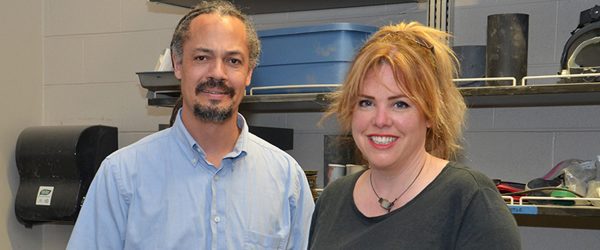Visiting Fulbright Fellow collaborating with engineering professor

Roisin Hyde, a Ph.D. student from Ireland, is using her Fulbright Fellowship to expand her studies of incorporating waste materials into the manufacturing of concrete. She selected UNC Charlotte in order to work with the Lee College of Engineering’s Brett Tempest, a pioneering researcher in the development of coal fly ash concrete.
A student at Queen’s University Belfast, Hyde was a practicing architect in Ireland for 15 years before returning to school to pursue a doctorate. She won a Fulbright Visiting Researcher grant in summer 2018 to expand her research in the development of a high-performance, low-impact, cement-free geopolymer concrete façade panel.
“I had been working in Ireland using locally generated industrial byproduct and waste materials, such as blast furnace slag and quarry dust,” Hyde said. “I read about the geopolymer concrete façade panels Dr. Tempest produced for the 2013 Solar Decathlon. He was the first person to successfully create geopolymer concrete sandwich panels made from coal ash. The project was groundbreaking as a full-scale application using an alternative cement made using chemically activated waste material.”
Concrete is one of the world’s most common building materials and is traditionally produced by mixing Portland cement with aggregate materials such as sand and rock. Portland cement is produced by firing limestone, a process that yields more than .75 tons of CO2 emissions for every ton of cement produced. The clinker production and energy consumed by the kilns in the manufacture of Portland cement are responsible for about 6 to 8 percent of the world’s carbon emissions.
Geopolymer cements are formed by chemically activating materials in a strong alkaline solution. The resulting paste can be mixed with aggregates and cured to form high-performance concrete.
Geopolymer concrete is a low-carbon alternative to Ordinary Portland Cement and can be made using industrial byproduct and waste materials such as coal ash furnace slag, incinerator ash and recycled materials.
“Our geopolymer concrete research at UNC Charlotte has been almost exclusively with coal fly ash,” said Tempest, a faculty member in the Department of Civil and Environmental Engineering. “When Roisin called and said she was interested in working with us to explore the use of other alternative waste materials, we were thrilled. Being able to branch out into other waste materials has been very helpful. Roisin is extremely resourceful working with area companies and getting materials to experiment with.”
The companies and the waste materials they are providing currently include Gerdau, smelter waste from steel recycling; Martin Marietta Mallard Creek Quarry, ultra-fine granite dust; West Virginia Alloys, silica fume; Sunrock Quarries, basalt quarry dust; and Lehigh-Hanson, granulated blast furnace slag. For use in geopolymer concrete, researchers crush the material to sizes ranging from one micron to 3 millimeters, before chemically activating it with an alkaline solution.
“We are fortunate that modern digital analytic technologies and chemistry allow us to identify suitable materials through X-ray diffraction and other methods to see how well they will work in concrete,” Hyde said. “For centuries, construction workers have just been using trial and error to see what worked. Now we can analyze nano-properties and adapt our mixes. This takes a lot of the guess work out. It is quantifiable.”
In addition to developing ways of making geopolymer cement, Hyde is researching more environmentally friendly methods for forming the material into concrete. As an architect, Hyde works with thin, high-performance concrete used for cladding building exteriors with complex geometries. The creation of such concrete panels currently produces large amounts of waste.
“There are a lot of opportunities for eliminating waste in the way high-performance concrete is manufactured,” Hyde said. “Current techniques use custom-made polystyrene molds. The concrete is poured into flexible rubber molds which are placed on the polystyrene form, covered and then vacuum-sealed to remove air bubbles. Once cured, all of the molding material and packaging is thrown away.”
Hyde is developing a re-configurable system where the concrete is placed in the mold, vibrated and then shaped by an array of digitally adjustable pins.
Read more on the Lee College of Engineering website.